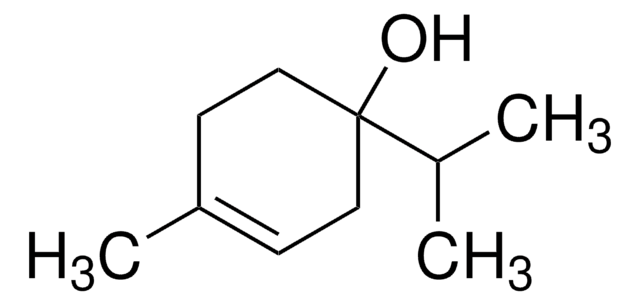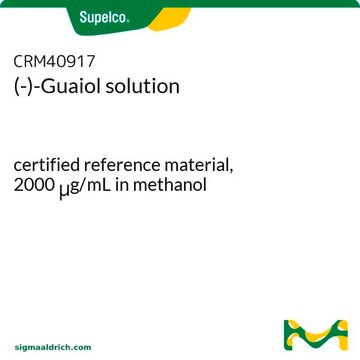86476
γ-Terpinene
analytical standard
Synonym(s):
1-Isopropyl-4-methyl-1,4-cyclohexadiene, p-Mentha-1,4-diene
About This Item
Recommended Products
grade
analytical standard
Quality Level
vapor density
4.7 (vs air)
vapor pressure
~0.7 mmHg ( 20 °C)
assay
≥98.5% (GC)
shelf life
limited shelf life, expiry date on the label
technique(s)
HPLC: suitable
gas chromatography (GC): suitable
refractive index
n20/D 1.474 (lit.)
n20/D 1.474
bp
182 °C (lit.)
density
0.85 g/mL at 25 °C (lit.)
application(s)
cleaning products
cosmetics
flavors and fragrances
food and beverages
personal care
format
neat
storage temp.
2-8°C
SMILES string
CC(C)C1=CCC(C)=CC1
InChI
1S/C10H16/c1-8(2)10-6-4-9(3)5-7-10/h4,7-8H,5-6H2,1-3H3
Inchi Key
YKFLAYDHMOASIY-UHFFFAOYSA-N
Looking for similar products? Visit Product Comparison Guide
General description
Application
γ-Terpinene may be used as an analytical reference standard for the quantification of the analyte in Thymus vulgaris L. oil samples using gas chromatography coupled to mass spectrometry (GC-MS).
Other Notes
signalword
Warning
hcodes
Hazard Classifications
Aquatic Chronic 2 - Flam. Liq. 3 - Repr. 2
Storage Class
3 - Flammable liquids
wgk_germany
WGK 2
flash_point_f
124.9 °F - closed cup
flash_point_c
51.6 °C - closed cup
ppe
Eyeshields, Faceshields, Gloves, type ABEK (EN14387) respirator filter
Choose from one of the most recent versions:
Already Own This Product?
Find documentation for the products that you have recently purchased in the Document Library.
Customers Also Viewed
Protocols
-β-Farnesene; α-Huµlene; Germacrene D; (+)-Valencene; Bicyclogermacrene; (+)-δ-Cadinene
Our team of scientists has experience in all areas of research including Life Science, Material Science, Chemical Synthesis, Chromatography, Analytical and many others.
Contact Technical Service












